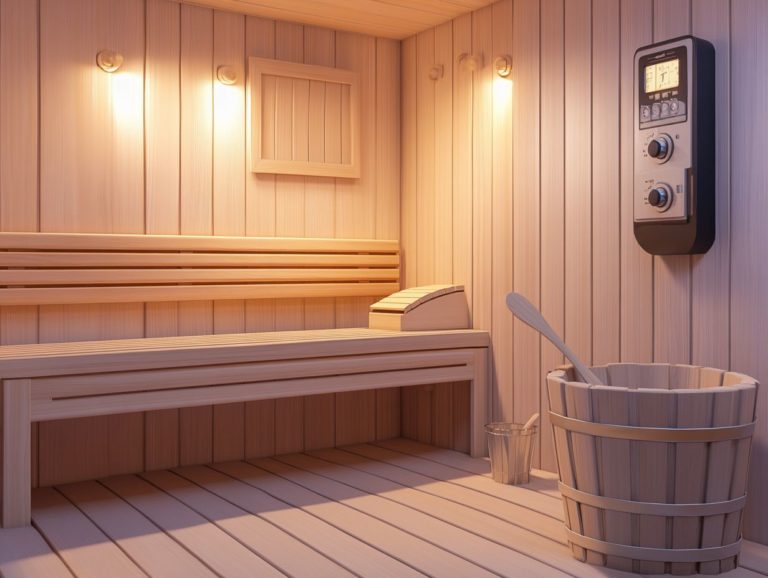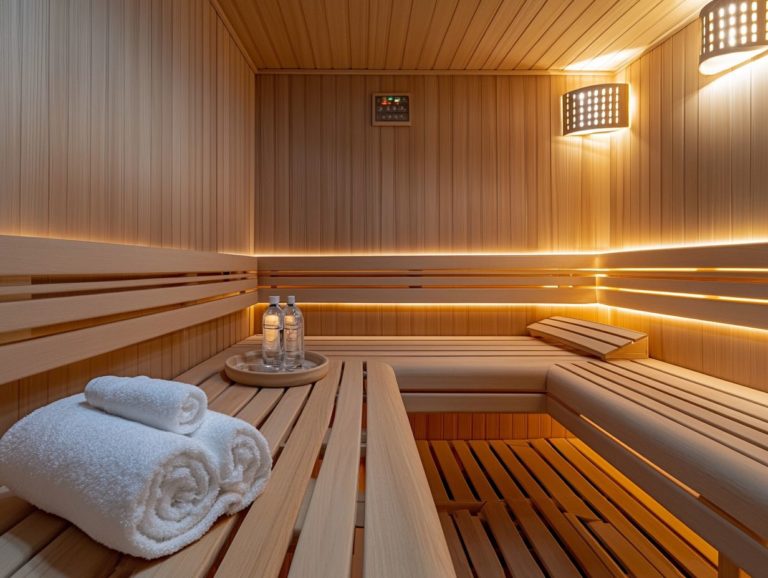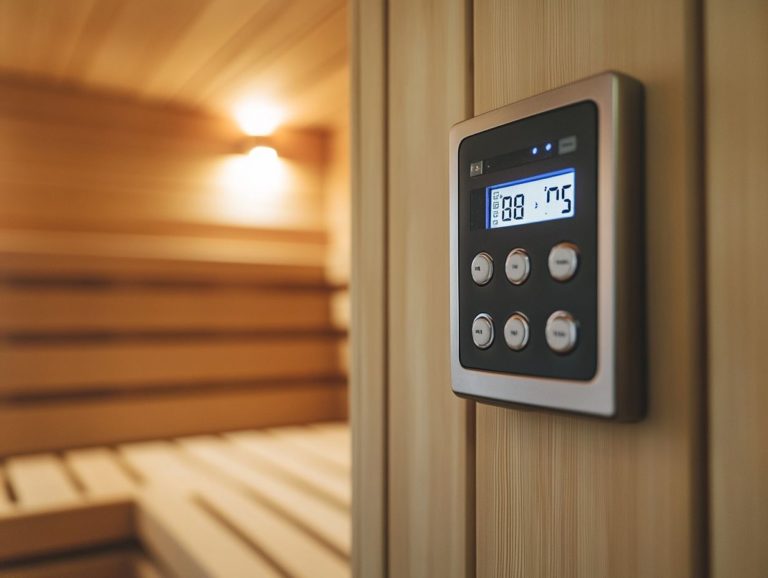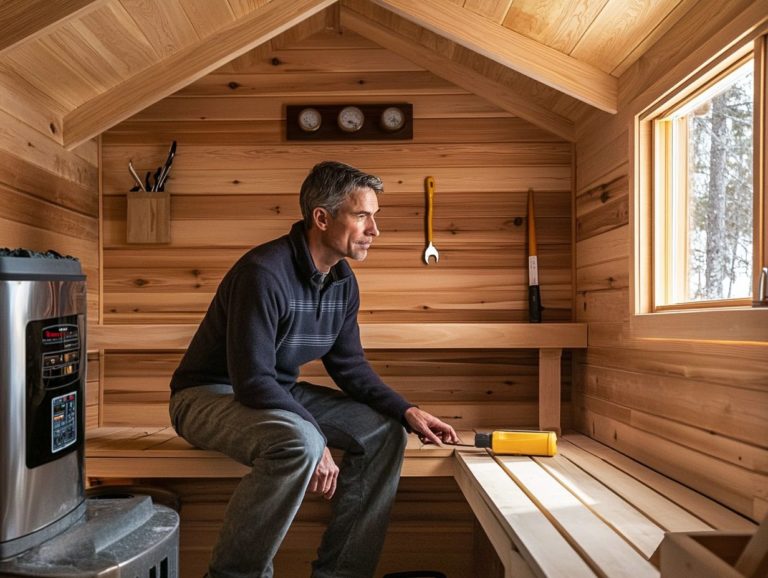Understanding Sauna Maintenance Costs
Maintaining a sauna is crucial for ensuring its longevity and optimal performance. But what should you expect when it comes to those maintenance costs?
Several factors can influence your expenses, ranging from the type of sauna you own to how frequently you use it. This article dissects the various components of sauna maintenance, covering both regular and seasonal tasks. Get ready to uncover tips that will keep your sauna in top shape!
It also reveals the hidden costs of ignoring maintenance. Whether you’re a seasoned sauna aficionado or just dipping your toes into the world of heat therapy, you’ll discover valuable insights to keep your sauna in pristine condition.
Contents
- Key Takeaways:
- Factors Affecting Sauna Maintenance Costs
- Types of Sauna Maintenance
- Cost-saving Tips for Sauna Maintenance
- DIY vs Professional Maintenance
- Energy-efficient Upgrades
- Long-term Costs of Neglecting Sauna Maintenance
- Frequently Asked Questions
- What is included in sauna maintenance costs, which vary based on sauna size and type?
- Are sauna maintenance costs the same for all types of saunas?
- How often should I schedule maintenance for my sauna?
- Can I do sauna maintenance myself?
- Do sauna maintenance costs increase over time?
- Is investing in a sauna maintenance plan worth it?
Key Takeaways:
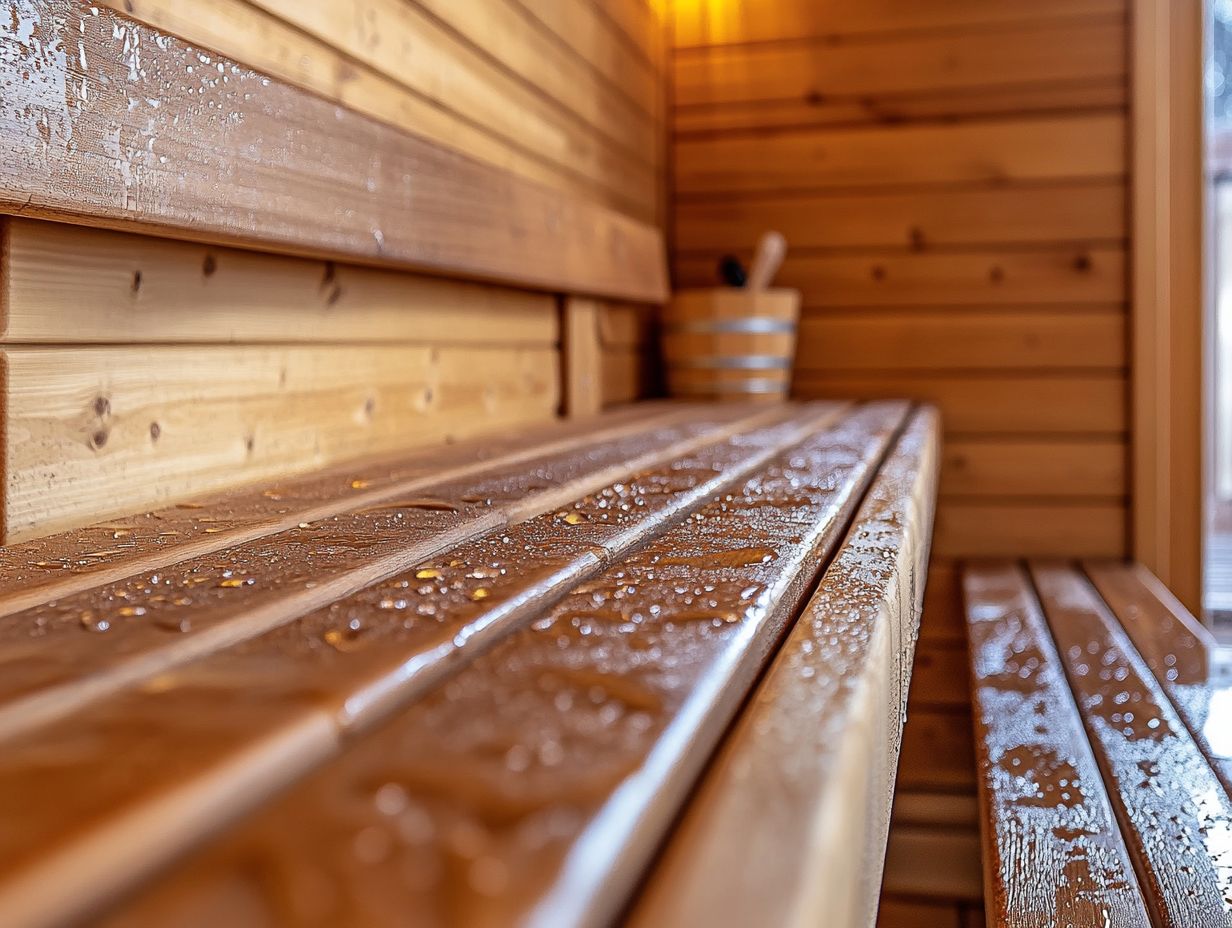
- Regular maintenance tasks, like cleaning and replacing parts, are your secret weapon to keeping those costs down!
- Climate and frequency of use can significantly impact the cost of maintaining a sauna.
- Ignoring sauna maintenance can lead to expensive repairs and potential damage, making it important to invest in proper upkeep.
Factors Affecting Sauna Maintenance Costs
Understanding the factors that influence sauna maintenance costs is essential for anyone thinking about investing in a home sauna or a custom sauna, whether it’s an infrared sauna, traditional sauna, or steam sauna.
Regular maintenance is key to ensuring both longevity and performance. These can vary significantly depending on the sauna type, the materials involved, and even the climate where you live.
As a homeowner, assess the operating costs tied to your specific sauna type, including energy consumption (the amount of electricity your sauna uses) and installation fees (the cost to set up your sauna). The frequency with which you use the sauna will also play a critical role in shaping your ongoing maintenance expenses, which can accumulate over time. For more detailed insights, check out understanding sauna insulation and maintenance.
Type of Sauna
The type of sauna you choose greatly influences your maintenance costs. Each option infrared, traditional, steam, outdoor, or indoor comes with its own unique requirements and associated expenses.
For example, infrared saunas are often easier on the wallet when it comes to energy consumption and maintenance. They don t require water, which means less frequent upkeep and a more straightforward cleaning routine.
On the flip side, traditional saunas demand regular attention, especially for cleaning and maintaining heating elements. This can drive up your maintenance costs over time. To help manage these needs, refer to the ultimate guide to sauna care and maintenance. Steam saunas come with their own set of challenges, requiring extra care to prevent mold and mineral buildup, ultimately adding to your overall expenses.
In terms of installation, outdoor setups tend to hit your budget harder due to the need for weatherproofing (making sure it can withstand rain and wind) and potential electrical work. Indoor installations may be more cost-effective but can limit your space and ventilation options. Each choice presents its own set of pros and cons that you should consider carefully.
Frequency of Use
The frequency of your sauna use directly impacts maintenance costs. More frequent sessions typically lead to higher running expenses and more regular upkeep requirements.
When you indulge in the sauna often, parts like heaters, control panels, and wood surfaces endure increased wear and tear. This means you’ll need to conduct routine checks to ensure everything operates smoothly. Understanding why regular maintenance is crucial for saunas can help prevent unexpected repairs down the line.
By recognizing how the intensity of your usage correlates with maintenance needs, you can establish a balanced approach to both enjoyment and upkeep. Implementing a proactive maintenance schedule can help you avoid costly repairs over time.
Thus, consider how often you plan to use the sauna in relation to these financial responsibilities.
Ready to take charge of your sauna’s upkeep? Let’s dive in!
Location and Climate
The location and climate where you install your sauna can significantly impact your maintenance costs. These factors dictate the most suitable materials and installation methods for your setup.
For example, if you find yourself in a humid climate, opting for moisture-resistant materials like certain types of cedar or redwood may be wise. While this choice could lead to higher initial costs, it can save you from mold and decay issues in the long run.
On the flip side, if you’re in a dry climate, you might lean towards more budget-friendly options like hemlock. However, you should be prepared for more frequent upkeep since the dryness can cause the wood to crack.
Humidity levels also play a crucial role in determining the type of insulation required, which affects how well your sauna uses energy and overall operational costs. Thus, understanding your local climate does more than just guide your initial material selection; it also shapes your ongoing maintenance strategies and budget considerations, ensuring your sauna remains not only functional but also inviting throughout the year.
Types of Sauna Maintenance
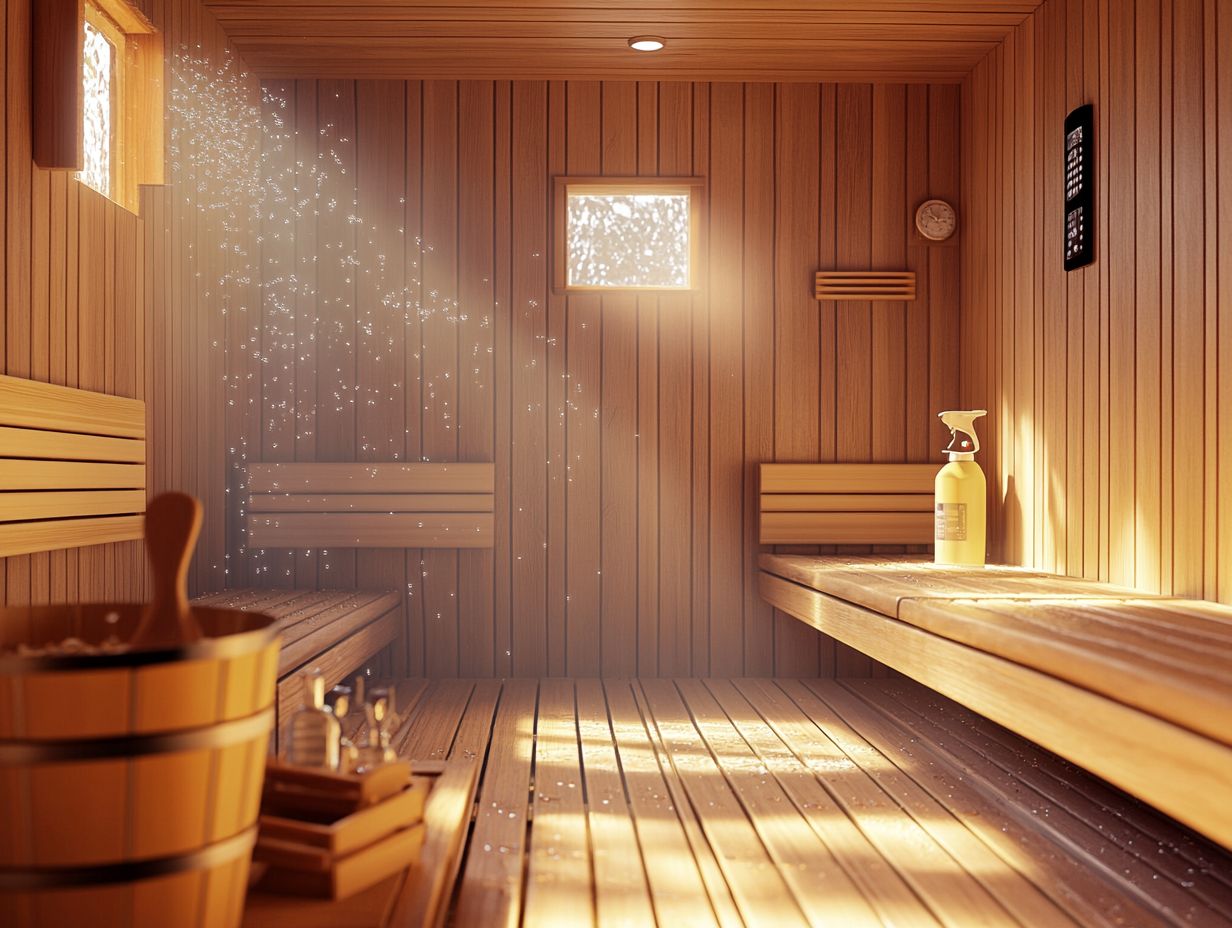
Knowing how to take care of your sauna is key to keeping it operational and safe for use over time. This involves conducting routine checks and evaluations tailored specifically to the type of sauna you own, whether it be infrared, traditional, or steam.
By prioritizing this knowledge, you enhance not only the longevity of your sauna but also your overall experience.
Regular Maintenance Tasks
Regular maintenance tasks for your sauna are crucial. These include cleaning, inspecting, and evaluating essential components to guarantee long-term functionality and safety.
For optimal performance, aim to clean both the interior and exterior of your indoor and outdoor saunas at least once a month. Use cleaning solutions that are gentle yet effective.
You should routinely check for any signs of wear or damage, such as loose panels or faulty electrical connections, as these could present safety hazards.
Every few months, take the time to inspect the heater’s function and ensure that the stones are in good condition to prevent any unexpected breakdowns.
Conducting these maintenance checks not only extends the life of your sauna but also ensures a safe and enjoyable experience for everyone involved.
Seasonal Maintenance Tasks
Seasonal maintenance tasks are essential for preserving the integrity of your sauna, especially in regions that experience significant weather fluctuations.
As winter approaches and temperatures drop, it becomes imperative to winterize your outdoor sauna to prevent damage from freezing temperatures and snow accumulation. This means draining water from pipes and using protective covers to safeguard surfaces from the elements.
During the warmer months, ensuring that your indoor sauna is well-ventilated is crucial to prevent heat buildup and humidity. These factors can negatively impact the sauna s materials and performance.
Regularly checking for moisture accumulation is key to thwarting mold growth and deterioration.
The natural expansion and contraction of wood due to seasonal changes makes it essential to regularly inspect and maintain sealants, ensuring the longevity and durability of your sauna structure.
Cost-saving Tips for Sauna Maintenance
By implementing cost-saving strategies for sauna maintenance, you can notably decrease your overall expenses while ensuring that your sauna remains in impeccable condition.
Embracing energy-efficient practices and exploring DIY options will not only enhance the longevity of your sauna but also contribute to a more sustainable approach to its upkeep.
DIY vs Professional Maintenance
Deciding whether to tackle sauna maintenance yourself or hire a professional will affect your costs and the quality of upkeep. This largely depends on the complexity of the tasks involved.
As a homeowner, you often weigh the pros and cons of each approach. Simple tasks, like cleaning the sauna or replacing wooden panels, are typically within your capabilities and can be done with relative ease.
However, for more intricate jobs such as sauna installation or repairing electrical components it s usually wiser to call in experienced technicians. Professionals bring not only their expertise but also specialized tools that ensure the work is performed safely and effectively.
Striking the right balance between self-reliance and professional support greatly influences the longevity and performance of your sauna. This ensures it remains a source of relaxation for years to come.
Energy-efficient Upgrades
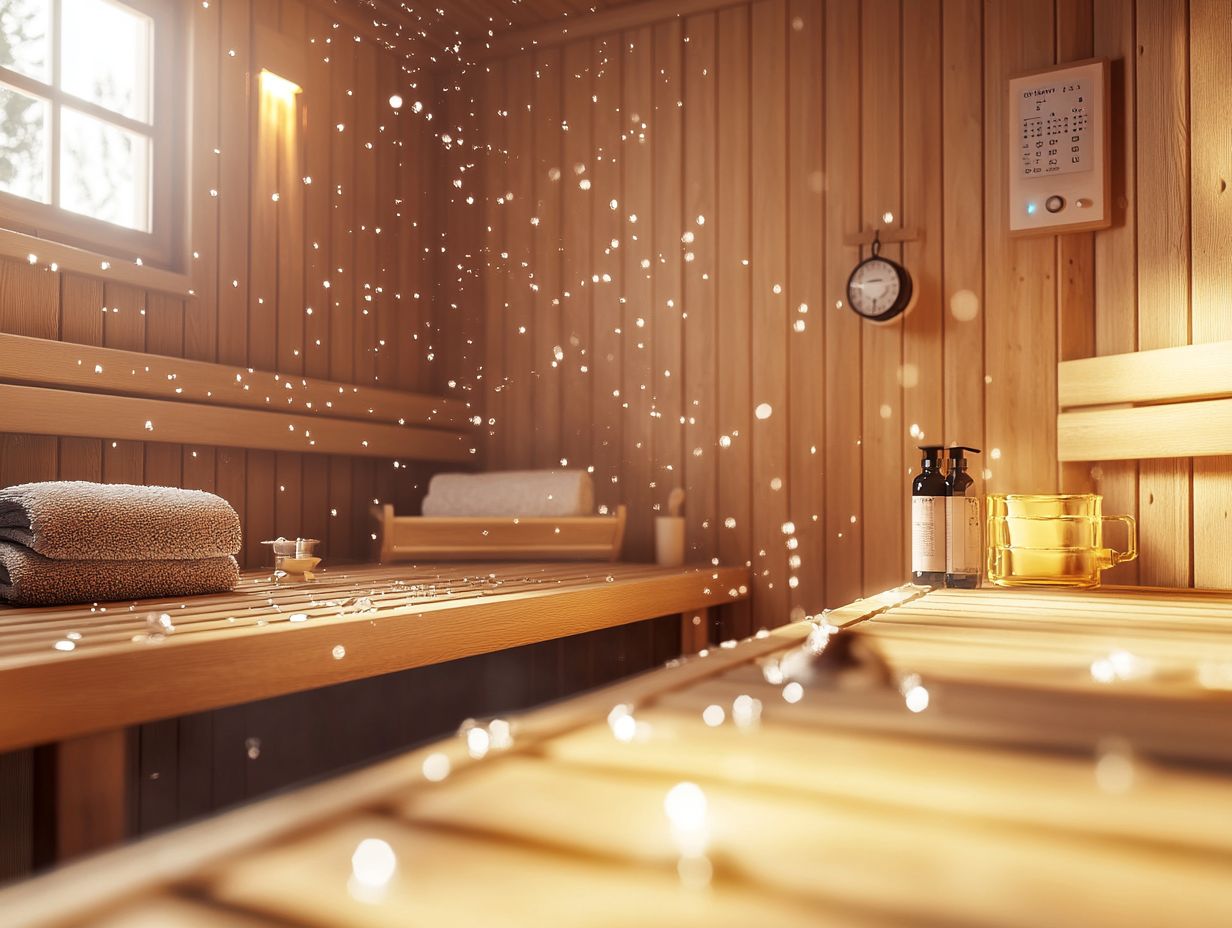
Investing in energy-efficient upgrades for your sauna will slash energy consumption, resulting in lower running costs and maintenance expenses.
For instance, incorporating advanced insulation material that keeps heat in for your steam sauna or outdoor sauna will help retain heat more effectively. This means your sauna reaches desired temperatures faster while using less energy.
Upgrading to modern heating elements may be necessary in both traditional and infrared saunas. These upgrades, such as infrared heaters and steam sauna options, boost efficiency and elevate your overall experience by delivering more consistent warmth.
Don’t overlook smart controls! Integrating these can further streamline your energy usage. Imagine being able to schedule heating times and regulate temperatures from your phone. For more insights, check out understanding sauna wiring and maintenance. All these upgrades combined can lead to impressive cost savings across various sauna types, including indoor and outdoor saunas, potentially slashing your energy bills by up to 30%, depending on usage and current systems.
Long-term Costs of Neglecting Sauna Maintenance
Neglecting sauna maintenance can lead to considerable long-term expenses. This may show up as expensive repairs, especially if you ignore maintenance on your custom or prefab sauna. Diminished efficiency can also increase sauna energy consumption and create safety risks, particularly in a home sauna environment.
Prioritizing regular maintenance not only safeguards your investment in high-quality sauna materials but also ensures a safe and enjoyable experience for you and your guests.
Potential Damage and Repair Costs
Ignoring sauna maintenance can result in potential damage, leading to significant repair costs and compromising both the functionality and installation quality of your sauna.
When essential components like heating elements or insulation deteriorate due to missed upkeep, repair costs can escalate rapidly. For instance, replacing malfunctioning heating elements might cost between $200 and $500, while repairing water damage from leaks or condensation could easily approach $1,000.
In contrast, implementing a routine maintenance plan typically costs only a fraction of these potential repair expenses, usually amounting to just a few hundred dollars annually. By investing in proactive maintenance strategies, especially for sauna installations that might involve plumbing and electrical work, you can avoid increased costs and ensure your sauna remains a delightful sanctuary for relaxation. Understanding sauna maintenance and temperature control is key to preserving its functionality.
Frequently Asked Questions
Have questions? Feel free to reach out for more information or guidance on sauna maintenance.
Start your maintenance plan today to avoid costly repairs tomorrow! Your sauna deserves the best care for optimal relaxation!
What is included in sauna maintenance costs, which vary based on sauna size and type?
Sauna maintenance costs typically include regular cleaning and replacing heaters. You may also need repairs to keep your sauna in good shape.
Are sauna maintenance costs the same for all types of saunas?
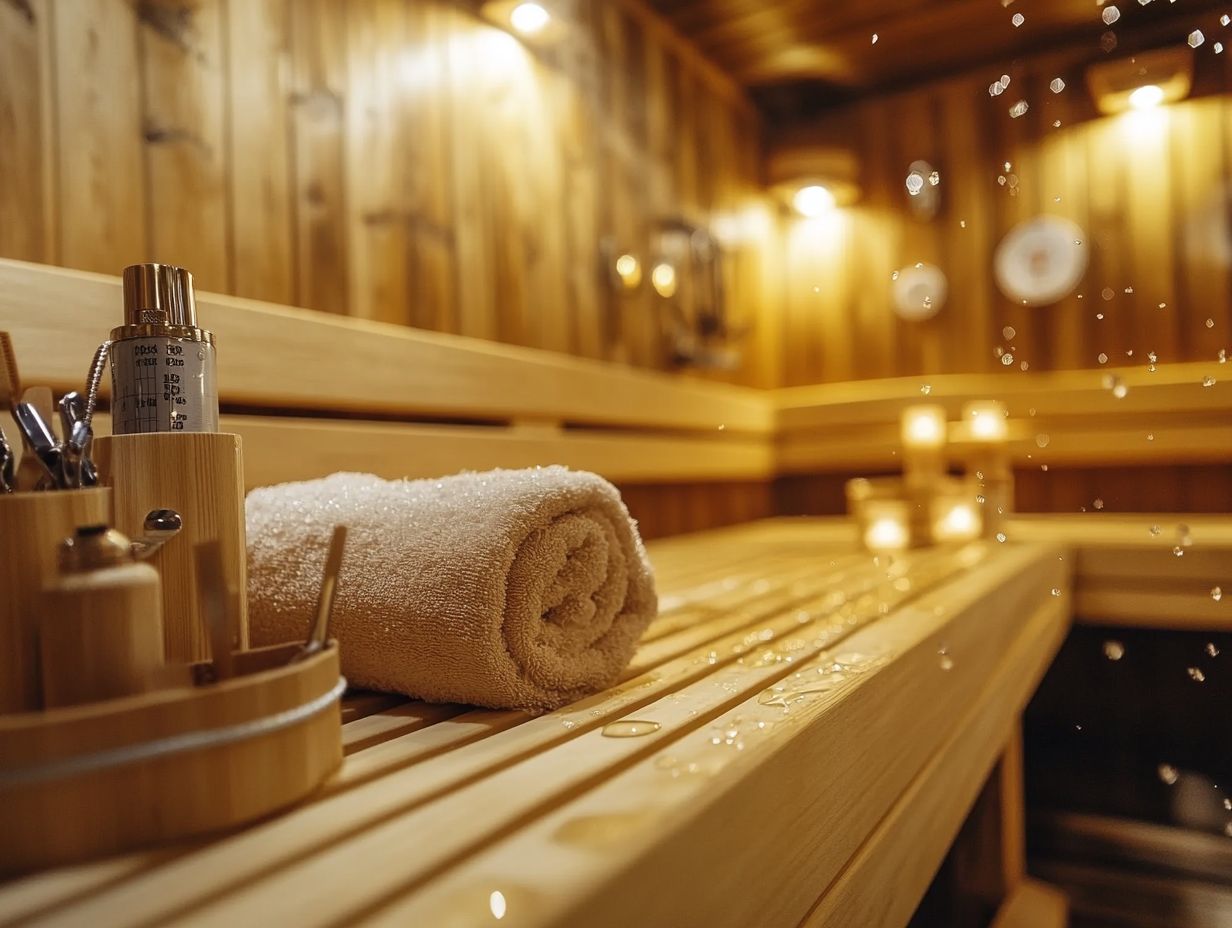
No, costs can vary by sauna type. Traditional saunas often require more maintenance than newer, infrared saunas, which use light to create heat.
How often should I schedule maintenance for my sauna?
Schedule maintenance at least once a year. If you use your sauna frequently, consider more frequent checks.
Can I do sauna maintenance myself?
Some basic tasks can be done by the owner. However, hire a professional for more complex work to ensure it s done correctly.
Do sauna maintenance costs increase over time?
Yes, older saunas may require more repairs. Regular maintenance helps catch issues early, preventing costly problems later.
Is investing in a sauna maintenance plan worth it?
If you use your sauna often, a maintenance plan can pay off. It helps catch issues before they escalate, saving you money in the long run.



